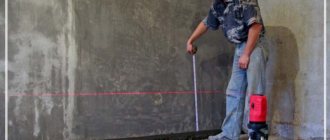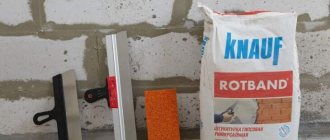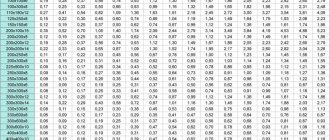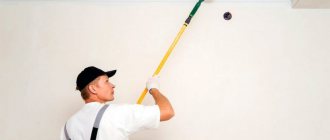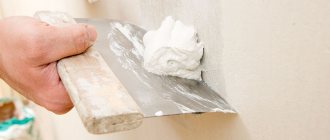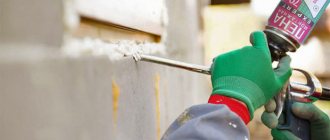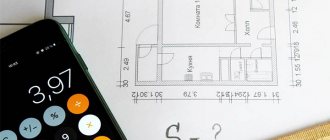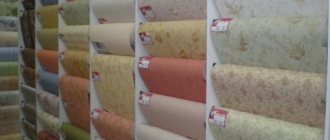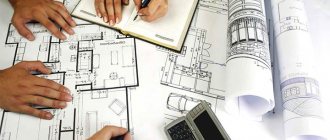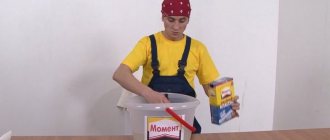Repairing and decorating walls is a complex process that is best left to professional workers. But if you decide to do the work yourself, it’s worth making a plan in advance and also considering wall covering options.
Liquid wallpaper is one of the most popular options for decorating and decorating walls during construction and renovation work. The popularity of this option is explained primarily by high quality, affordable cost and a fairly simple method of application.
Today in this article we will talk about ways to calculate the required amount of material, and also share the secrets of economical use of liquid wallpaper. If you also want to know how much liquid wallpaper you need, we recommend reading the information below.
Calculation of the area of the processed surface
However, you can calculate the required volume yourself.
To calculate, you will need to know the following dimensions:
- Find out all the dimensions of the walls (multiplying the dimensions will give you the total area of the walls in the house).
- Find out the dimensions of the doors in the room (their area will need to be subtracted from the total area of the walls).
- It is also necessary to find out the area of the windows; for this you should take measurements of each window.
- If there are ledges, columns and additional structures in the walls, you will need to find out their parameters separately.
Measurements to calculate wall area
After taking measurements, the final result should be calculated. To do this, it is enough to subtract from the total area indicator the space occupied by the area of windows and doorways, and also add to the resulting value the area of additional structures, if any.
The calculated indicator will be a key parameter for further calculations of the amount of mixture that needs to be purchased. For convenience, a special table was created indicating the required volume of the mixture for a certain area, however, it shows average values, so it is better to make all the calculations yourself.
Reasons for increased consumption
The main reasons for the increase in substance consumption per room include the following:
- Surface too smooth. Applying liquid wallpaper to it is much more difficult.
- Dark spots on the walls. To paint them over, you will have to spend more material.
- Long-term storage of the prepared solution.
- Violation of manufacturing rules.
- The presence of cracks and other defects on the walls.
When buying material from unknown manufacturers, you can also encounter problems: if the quality of the composition is low, the consumption will increase noticeably.
How to calculate the amount of wallpaper per room?
Once you have found out the area of the walls, it is worth calculating the total volume of consumables.
To accurately calculate the amount of materials, we recommend reading the information below, in which we will talk in detail about the consumption of liquid wallpaper per 1 square meter, as well as ways to save material.
Dry liquid wallpaper, consumption per 1 kg
If you are buying dry liquid wallpaper, the consumption of one package will allow you to calculate the total number of packs that you need to purchase. Professional workers in the field of construction and repair indicate that the consumption rate for 1 kg of liquid wallpaper is approximately 3-4 square meters. m of surface. In doing so, they use a layer approximately 2-3 mm thick.
Thanks to the information presented, you can find out how many kilograms of the mixture you will need.
Layer thickness 2-3 mm
Reasons for increased consumption
In some situations, the consumption of liquid wallpaper may increase, which leads to the need to purchase additional materials. Among the most common reasons for increased material consumption are the following:
- Walls that are too smooth will require more application of the material, since liquid wallpaper will not adhere well to the wall.
- A textured surface will require more material to smooth out uneven surfaces.
- If the house has dark walls, you will need to make a thicker layer of wallpaper, which will also lead to increased consumption of materials.
- The consumption is also affected by applying too thick a layer of material. Each pack of material is designed for a certain area; with an increase in the thickness of the wallpaper layer, it will be enough for a smaller section of the walls.
- The presence of defects and cracks on the surface also leads to an increase in wallpaper consumption.
Ways to reduce the consumption of liquid wallpaper
If you use a cheap option, then the increase in consumption does not play a special role. However, when using expensive options, it is worth learning how to save material. To save on materials used, you should use the tips below:
- You can apply wallpaper using a special spray gun. This will allow the material to be applied with a thickness of 1 mm, which will significantly reduce consumption rates.
- Carefully leveling the wallpaper layer will reduce the amount of material used.
- Using white putty will make thin layers of finish invisible.
- Due to thorough mixing of the liquid wallpaper, there will be no lumps or fibers in the mixture; this will also allow the coating to be evenly applied to the walls.
- Using leftovers from the previous solution will save money on purchasing new material.
Spray gun saves the consumption of liquid wallpaper
What affects material consumption
Preliminary calculations will help you understand how much substance will be needed to carry out repairs.
The consumption of liquid wallpaper is affected by the following features:
- Homogeneity of the substance. Wallpaper must be prepared by mixing the ingredients with water. With the wrong approach, there is a risk of getting a composition whose density is significantly different. If applied carelessly, the substance is distributed unevenly. As a result, the fill factor per square meter changes.
- Water volume. This substance is considered the main component of the wallpaper mixture. Without its addition, the mass will not fit normally on the walls. When making a solution, it is important to adhere to the correct ratio of liquid and powder - this affects the plasticity of the mass. If the mixture turns out to be too thick or too thin, it will not be possible to distribute it evenly over the surface.
- Time after cooking. If you use the composition a few days after production, it will lose its plasticity. This also negatively affects the consumption of the substance. Calculating the required amount of mass will be quite difficult.
The consumption of material is directly affected by the correctness of its application.
Control batch
Sometimes the information provided by the manufacturer does not coincide with reality.
If you do not know the exact volume of material that will need to be purchased for wall finishing, we recommend that you carry out a control batch according to the following plan:
- Prepare a small amount of material for application, 100-200 grams is enough.
- Apply liquid wallpaper to a small area of the surface, it is better to do this behind a closet or sofa, so that you can hide the place of the test application.
- After the test batch, make accurate calculations to determine the required volume of consumables. Depending on how many squares of material you need to purchase, the total number of packages will depend.
A test batch will show how long one package of your chosen liquid wallpaper will last
Calculation example
For those who do not trust the calculator too much and prefer to carry out the calculations themselves, we offer an example of how to calculate liquid wallpaper for the complete decoration of a room, taking into account the necessary reserve.
Initial data: a room measuring 5x6 m, height 3.2 m. Two windows measuring 1.5x1.5 m, arched entrance opening 3x2 m. Finishing the walls with liquid wallpaper to the full height, suspended ceiling.
We use liquid wallpaper from Silk Plaster (Russia), Rekot series (based on natural wood) with a consumption of 7 sq. m. from the packaging.
Total area to be finished
(5+6+5+6)x3.2-2x1.5x1.5-3x2 = 59.9 sq.m.
Round up to 60 sq.m. For such an area you will need 60/7 = 8.5 packages of dry mixture. Accordingly, you need to purchase 9 pieces. Considering that liquid wallpaper is not the most mechanically resistant material and the finish may require repairs during use, it is better to buy ten packs at once. When sealed, the dry mixture can be stored indefinitely and will allow you to restore the integrity of the coating at any time.
How to store diluted liquid wallpaper?
If you prepare too much wallpaper, you should set aside the material for later use:
- To this end, dry all remaining material by placing it on a plastic bag. It is recommended to dry different wallpaper formats in different containers.
- Once the mixture is dry, place it in a bag or large airtight bag, after removing the air from it.
- When reusing, you only need to add water to the composition.
Tyutyunnikov Dmitry
Article verified by a decorative finishing specialist
How to reduce consumption
Applying liquid wallpaper is considered a rather complex procedure that requires a number of skills. However, there are a number of ways to help reduce consumption.
To do this, the master must follow the following rules:
- Apply the solution using sprayers. This will help distribute the substance more evenly over the surface.
- Level the walls. The better the base is prepared, the less composition is required.
- Use special primers. Experts advise using deep penetration mixtures that reduce the absorption of material by the wall.
- Use white putty. The shade of the walls shines through the material. To paint it over, you need to increase the amount of substance.
Liquid wallpaper is considered a fairly common finishing product that allows you to obtain a high-quality coating. Before purchasing material, each person must calculate its quantity. This will help avoid many problems that often arise during repairs.
What other recommendations are there?
It is recommended to keep one package of liquid wallpaper in stock, so that later it will be easier to carry out repairs if necessary.
Temperature and air humidity determine the time during which liquid wallpaper dries completely. Typically this process takes 2-3 days. Dark wet wallpaper becomes lighter as it dries. It doesn't matter how much composition is used.
There is no need to prepare the surface, but carrying out such work will help you significantly save on the purchase of finishing materials. It is recommended to putty the entire wall. Then the working surface will be the same in all areas.
The primer will add strength to the surface and protect it from moisture penetration.
Advice! If the wall is initially dark, its color can be seen even after the wallpaper has dried. Before applying liquid wallpaper, it is better to paint such surfaces white. For this, water-based paints are used.
For economical consumption, it is recommended to maintain a layer thickness of 2-3 millimeters. This is if the packaging does not indicate other, more optimal parameters that the wallpaper has. The indicators should not be exceeded, otherwise the coating will not be durable enough. The thicker the layer of wallpaper, the harder it is to work with. Drying time increases.
The high cost of liquid wallpaper from leading manufacturers does not always become a symbol of better quality. Sometimes it is the same for those materials that are cheaper or made independently. The overpayment appears only at the expense of the brand. The average will be the least impact on the budget, and the quality will remain at an acceptable level. The photo shows a clear example of how to correctly calculate sq. meters of area for applying liquid wallpaper:
Premises with a complex configuration are usually divided into several sectors. It is easier to calculate the total area if you multiply all the parameters of the height, width and length of the room. This rule applies to different niches with different elements. For example, refers to columns. Simply multiplying the length with the width will help in determining the ceiling area. But for it it is better to take more mixture, since this surface causes the most problems and, accordingly, consumption. For the ceiling, you need to remember that when making liquid wallpaper yourself, add a little more adhesive to the batch.
How to make liquid wallpaper yourself and correctly calculate the consumption per square meter. The following video will help the meter:
Recommended Posts
What can be made from old wallpaper
How to make liquid wallpaper at home
Liquid wallpaper Silk plaster
Liquid wallpaper: application technology
Do-it-yourself liquid wallpaper: from newspapers, old wallpaper, sawdust, uh...
Is it possible to apply liquid wallpaper to drywall?
"Moment"
The German brand is well known in our country. The range of its products is huge, including wallpaper glue. Such compositions are of excellent quality and hold the canvases quite firmly on the wall. However, in order for the canvases to adhere well to the wall, careful preparation of the surface is required.
The glue glides perfectly, so the canvases are easily joined. The adhesive composition includes components that protect walls from mold and mildew. The composition is prepared quickly and stored in a sealed container for a week.
When purchasing wallpaper glue, you need to pay attention to its composition. If it is based on modified starch, then it is suitable for light types of wallpaper
This glue has poor adhesion ability of the canvas to wood and concrete surfaces.
Wallpaper glue based on carboxymethylcellulose is considered to be the most tenacious. True, it can only be applied to well-prepared plastered surfaces. It is not suitable for painted walls. For such surfaces, a less tenacious composition based on methylcellulose with the addition of PVA is more suitable.
If you plan to glue heavy wallpaper (metallic, with wood admixtures, fabric), then you need to choose compositions with a polyvinyl acetate content of less than 25%. The wallpaper will stick firmly to the walls if the glue contains at least 50% PVA.
Typically, on the glue package, the manufacturer indicates a list of surfaces on which this composition can be used. The vast majority of modern adhesives can be used on a wide variety of surfaces.
The amount of antifungal and antibacterial impurities should not exceed 3%. If this indicator is significantly higher, then the glue may be harmful to the health of people living in the house.
The hygiene of the purchased material is of no small importance. Normally, the PH value of the glue should be at least seven
A composition with lower parameters will leave yellow stains on light-colored wallpaper. Therefore, for light-colored canvases it is recommended to purchase glue with a pH value of 10 or more.
An important indicator of glue quality is the hardening time. A high-quality composition dries in 18-20 minutes.
If you plan to renovate rooms with high humidity levels (kitchen, bathroom, toilet), choose glue with fungicidal and bactericidal additives. They can prevent the appearance of fungus and mold on the walls.
Experts recommend giving preference to highly targeted formulations. When working with elite types of wallpaper, we recommend Sem-Murale glue from the Semin company or ready-made Kleo compounds.
How to prepare walls for applying liquid wallpaper?
How to prepare walls for liquid wallpaper
- First remove old layers of paint and plaster. ...
- Also get rid of elements sticking out from the walls: nails and other parts.
- Be sure to treat fittings or pipes that cannot be removed: you can put a 2 mm layer of putty on top or cover them with oil paint.
18 Feb
2022 Interesting materials:
What is aircraft engine thrust? What is matrix type pls? What is TMS in accounting? What is totemism in history? What is a partnership of faith? What is a shopping cart? What is Trade in car? What is cross-border transfer of personal data? What is transport? What is Tribulus sports nutrition?
Counting principle
When you know approximately how much glue is needed for each m2, you need to start calculating. They are carried out quite simply. It is necessary to measure the length of the walls and the height of the ceilings for each room. Based on this, you can calculate the area of each wall.
Next, you need to subtract from this area those areas that will not be used in any way, for example, windows or doors; their area is also very easy to measure. After this, it is worth making adjustments to the surface - whether a preliminary primer is needed, or in this case it is realistic to do without it, as well as its type.
Priming walls with wallpaper glue before gluing
Next, using the instructions on the back of the package, you need to calculate the approximate glue consumption in this case, based on the type of wallpaper you have. If for some unknown reason it turns out that you have glue without the original packaging, then you can take the approximate values that were given just above.
After this, you simply need to multiply the data from the packaging by the total area of wallpaper in each room. You can take a little more glue so that in the future, if you need to re-glue any part, there will be a reserve. As a result, you will come up with a number, usually several kilograms, which will indicate exactly how much glue you will need. If suddenly you need to paste over the ceiling as well, it also needs to be taken into account.
Bright wallpaper on the ceiling
Remember that buying a little more glue will be a smart decision, but it’s not worth buying it for future use, because each glue has its own expiration date, and gluing is already dangerous, and besides, it will no longer be as effective. It turns out that you will simply waste the extra money without winning anything.
Which glue is more economical
If you want to choose glue that will be used most economically, then you should give preference to liquid variations. Their quality will be the highest, they will not have lumps or other imperfections. But there is a catch, which is that these adhesives are more expensive than others. So, in an effort to save money, you may end up spending more money.
03.12.2015
Dec 03, 2015
In most cases, the packaging of wallpaper glue indicates its consumption per square meter. However, in reality, there is almost always excess glue left or not enough and you have to run to the store for new packaging. What this is connected with and how to correctly calculate the consumption rate of wallpaper glue per 1 m2, we will talk in this article.
Let's start with the fact that a plastered wall absorbs glue well, and if it is not applied to it first, then you will have to use more glue than the amount indicated on the package, approximately +5-10 g per square meter.
The second point on which the consumption of wallpaper glue will depend is the area to be covered. When completely covering walls with wallpaper, calculations must be based on the entire area of the walls. If you plan not to touch the space behind the furniture or implement other design ideas, not the entire surface of the walls will be covered with wallpaper, and accordingly, you will need less glue. In this case, from the total area of the walls it is necessary to subtract the area of those areas that will not be covered with wallpaper.
The third point that you should pay attention to when calculating the consumption rate of wallpaper glue is the type of wallpaper. In some cases (paper wallpaper) the glue is applied to the wallpaper itself, in others (non-woven, vinyl) - on the wall
Different absorbent properties of surfaces and drying speeds cause different glue consumption.
Finally, in order to achieve the best result, you need to use a different adhesive for each type of wallpaper. This information is always indicated on the packaging.
Measuring the area of a room
As mentioned earlier, without accurately measuring all three main parameters of the room, it will not be possible to calculate the exact number of rolls of wallpaper. This is especially true when you need to cover not just one room in an apartment or house, but several.
To make it easier to visualize, you will need to draw a general schematic plan of the room. To do this you will need a pencil, a ruler and a simple sheet of paper. You will also need a tape measure with which to measure the space.
Having schematically marked the walls and the location of the windows on paper, you need to sign such values as the height of the walls, the width and length of the room itself. Then specify the window parameters in order to subtract them from the total footage, since they do not need to be covered.
Next, we find out the area of each wall and add it together to find out the total number. To do this, we multiply the height by the width. Let's say that this space has a height of 2.5 m, a width of 3 m, and a length of 4 m.
Let's find out the area of the first wall: 2.5x3 = 7.5 sq. m. Next, we multiply this number by 2, since there are two such walls - they are opposite. 7.5 sq. m x 2 = 15 sq. m – a total of 2 walls. We do the same with the other two. (2.5 m x 4) x 2 = 20 sq. m. Add up the resulting values – 10 +15 = 25 sq. m is the area of the entire surface of the walls in the room.
Don’t forget about the window surface area that needs to be subtracted. First, it must be calculated in a well-known way. Let's take the dimensions of a regular window - width 1.35 m, height 1.45 m. 1.35 x 1.45 = 1.96 sq. m. The result obtained is subtracted from the total surface area of the walls of the room - 25 -1.96 = 23.04 square meters. m – area of the wall surface to be pasted.
Every room has an entrance door or passage, which is also not a surface; it does not need to be covered with wallpaper. In this regard, the surface area of the door and the entrance space itself must be subtracted from the above total wall area. An ordinary door with a transom has a height of 2.5 meters and a width of 0.8 m. 2.5 x 0.8 = 2 square meters. m (the area of the door with the gap from it to the ceiling).
We subtract the calculated area from the total - 23.04 - 2 = 21.04 square meters. m.
From the obtained result, using simple mathematical calculations, you can find out the number of required rolls of wallpaper for the room, knowing the coverage area of one roll.
Non-standard surfaces
There are also rooms that have a non-standard layout, but the calculation must still be carried out. To be 100% accurate, even if a room has standard sizes and parameters, the walls are not always even and they must first be leveled, otherwise the ornament or pattern on the wallpaper will be difficult to fit along the entire surface of the walls.
Unusual surfaces include walls with rounded corners, or when the wall itself has the shape of a semicircle. There are rooms where the walls are rounded towards the ceiling and have a domed top. There are also protrusions or partitions that divide the space into zones and so on.
To determine the number of rolls of wallpaper, you still have to calculate the area in this case. Masters advise “cutting” the space into convenient shapes (square, rectangle). To do this, take the width of the wall and its height at the highest point and mentally connect it into a rectangle. Rounded triangles will remain at the corners, which are also divided into squares. Later, all the sums of the areas are added up, and the total area is obtained.
But many “experienced” upholsterers say that there is no need to calculate so thoroughly.
If the wall has the parameters of an ordinary rectangle, but a convex shape in the form of the Russian letter c, then its width is measured using a tape measure, which must be pressed tightly to the surface. The height will be normal, without any problems or any changes. And then the area is calculated using a formula known to everyone.
If there are convex parts or certain structures on the wall (for example, a hood pipe that is covered with rectangular sheets of plasterboard or PVC), then its area must also be calculated and added to the total surface. It’s good when it has a clear angular shape, like a square or rectangle, but if there are rounded parts, then it’s also better to calculate them, like “regular” shapes, and then remove small excesses with a knife.
Best materials
Finally, it is worth mentioning several durable varieties of wallpaper that will decorate the interior of any room, will not complicate the work process, will emphasize the subtle taste of the apartment owners, will look beautiful and will allow you to save on finishing, reducing the possibility of defective finishing work to a minimum. These include:
- non-woven fabrics - ecological wallpaper, one meter wide, that does not emit harmful substances into the air, practical and beautiful fabrics, easy to paste;
- textile - advanced premium wallpaper for gluing by experienced craftsmen, which does not require treating the back side of the material with an adhesive;
- silk-screen printing - options with embossing on a vinyl base, double-layer wallpaper with the appearance of silk textiles;
- glass wallpaper is a material that is created on a loom, giving it a clear, fixed shape through additional impregnations;
- for painting - plain wallpaper on a paper, non-woven or glass base, characterized by minimal consumption of facing material and the presence of a textured surface.
Of these, the minimum consumption will be for varieties for painting and liquid wallpaper. They do not need to adjust the pattern. These materials also include glass wallpaper, which can be painted up to 20 times.
You will learn more about how to calculate the amount of wallpaper per room in the following video.
Application process
If you decide to choose liquid wallpaper for wall decoration, what is the consumption of this material, you should ask why you need to read the instructions. If it is not provided, you can use the information in the article as a guide. To apply the finished mixture, you can use a spatula from 18 to 80 centimeters, a trowel, a metal/plastic grater or a spray bottle. There are special graters for this material, which differ from standard ones in that they have a slightly narrower blade. They are quite often made of transparent plastic, which allows you to effectively control the smoothing process. This helps when creating an application from different types of wallpaper.
The process should not cause any particular difficulties; it is similar to applying putty, in some ways even easier. The solution must be scooped up with your hands or a small spatula, and then placed in portions on the wall. The tool is used to rub the mixture over the surface. You should aim to get a layer that is 3 millimeters thick.
Surface type
Consumption also directly depends on what kind of material the gluing is carried out on. For example, if it is wood or fiberboard, then the consumption will be minimal. The reason is that the glue penetrates very quickly into the top layers and sticks very quickly. With other materials everything is somewhat more complicated.
Wallpaper sticks easily to a flat surface
For example, concrete, stone or plaster do not have the same properties, so they require slightly more glue. Therefore, when working with such surfaces, feel free to add 5-10% to the amount calculated in advance.
Average consumption
To roughly understand what exactly the consumption of this or that glue will be, you need to pay attention to the turnover of its pack. Usually it indicates the approximate amount of glue required for gluing wallpaper of one type or another.
It is difficult to give universal figures, because each brand of adhesive composition has its own distinct characteristics.
Information on the back of the wallpaper paste pack
If we still take some average indicators, then for thin paper wallpaper it is usually 15 grams per m2. If you take thicker wallpaper, for example, vinyl, then this figure can reach up to 50 grams per m2.
But, again, you still need to study the information on the pack as carefully as possible in order to take into account the characteristics of different types of glue and different wallpapers.
